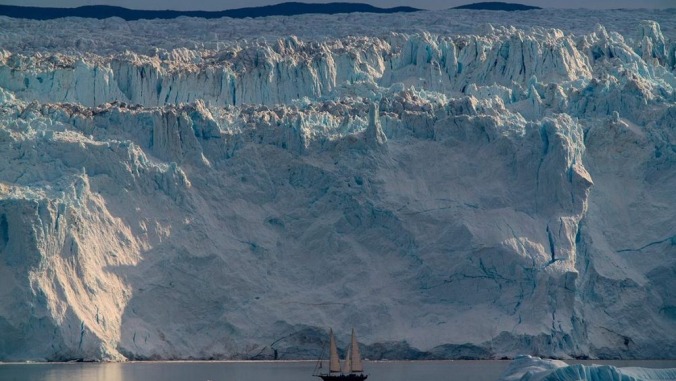In the arty documentary Aquarela, water is both hero and villain


For its first 15 minutes, Viktor Kossakovsky’s documentary Aquarela plays like a combination of sobering ethnography, silent comedy, and Hitchcock thriller. On Siberia’s semi-frozen Lake Baikal, a group of men with wooden poles and coils of wire are seen walking across the ice in long takes, in search of something unknown, submerged below. Eventually, in a striking overhead shot, Kossakovsky reveals their quarry: A car has fallen through the fragile surface into the water, and these guys are intending to haul it out. But they keep breaking the ice themselves, and slipping below, laughing at their own folly. And then, off in the distance, Kossakovsky’s crew catches sight of another car, speeding across the lake, headed toward certain doom.
Aquarela is ostensibly a movie about humanity’s relationship with water, though Kossakovsky never explains that as such. There are no on-screen titles or talking head interviews to clarify what the audience is seeing, and though there are a few human characters scattered throughout the film, they rarely talk and they’re never identified. Instead, the soundtrack mostly consists of ambient sounds of ice cracking and water flowing, enhanced by occasional ear-splitting blasts of music from the hybrid classical/metal band Apocalyptica.
So unless viewers have read Aquarela’s advance reviews (or have access to the press materials), they’ll have to wait until the closing credits to find out the opening sequence was shot in Siberia. They also probably won’t recognize everywhere the movie moves on to next, as Kossakovsky’s crew films icebergs floating in Greenland; the roiling waves complicating a small schooner’s perilous Atlantic crossing; some vertiginous views of Venezuela’s breathtaking Angel Falls; and shocking scenes of communities in California and Florida devastated by floods and hurricanes. Aquarela isn’t telling any particular story, nor is it an advocacy doc per se. It’s more of a compendium of astonishing images and sounds, intended to overwhelm.
To aid in the immersion, Aquarela was shot in an ultra-clear high-definition format, at 96 frames per second. It’s being projected at the same rate in theaters with the proper equipment (though it’s mostly playing in houses set up for 48 fps). Aquarela is meant to feel like a habitat. And like some of the more contemplative nature films—or like Godfrey Reggio’s ’80s arthouse classic Koyaanisqatsi—when this movie’s really working, it’s transportive.
It works more often than not. Kossakovsky demands some patience, as he shifts from segment to segment abruptly, giving the audience little time to reorient themselves—and no cue that they should. But eventually, each of the movie’s passages hits an emotional crescendo, akin to the moment in Siberia when it becomes clear that the car zooming across Lake Baikal is likely headed toward a hole in the ice. The strongest stretches of Aquarela tend toward total abstraction, where light shimmers across the underside of an ice floe, or big chunks of ice bob up and down like giant whales, or towering walls of water fill the frame—all captured with cutting-edge filmmaking technology.
There is a point to all this, and it’s not that hard to unpack. The sequence in Siberia shows the impact of a warming climate, as does the footage of Miami streets being battered by Hurricane Irma. All the awe-inspiring shots of ice-falls and waterfalls stress the power and majesty of Earth’s primary natural resource, showing how much humanity is at its mercy. But Aquarela is first and foremost a spectacle. When the Apocalyptica music is cranked up high, and the screen’s awash in dazzlingly sharp, hypnotically swirling images of cresting waves, viewers could certainly take a moment to contemplate the importance of water to our global ecosystem. Or they could just drink it in.